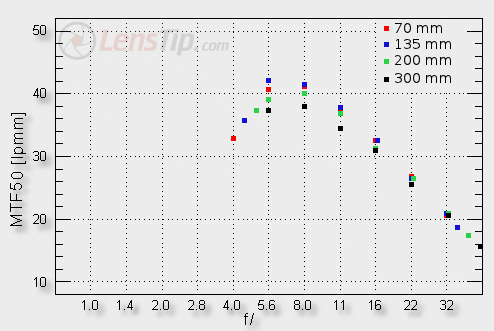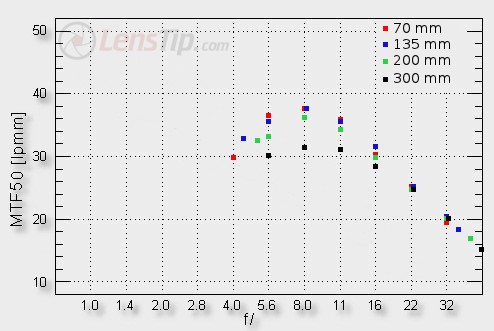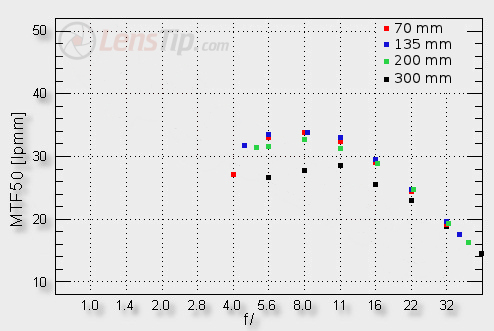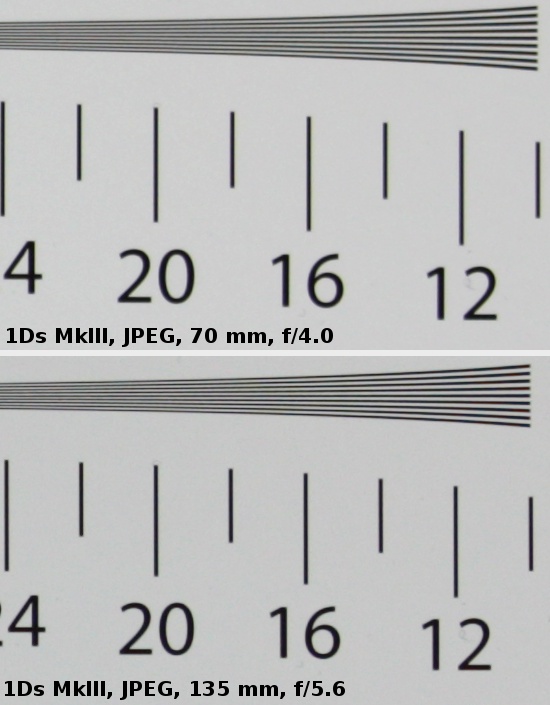Canon EF 70-300 mm f/4-5.6 L IS USM
4. Image resolution
Let’ s check how the tested lens fares in the frame centre by looking at a graph below.

Please Support UsIf you enjoy our reviews and articles, and you want us to continue our work please, support our website by donating through PayPal. The funds are going to be used for paying our editorial team, renting servers, and equipping our testing studio; only that way we will be able to continue providing you interesting content for free. |
- - - - - - - - - - - - - - - - - - - - - - - - - - - - - - - - - - - - - - - - - - - - - - - -
Usually in 70-300 mm class lenses we observe a gradual and sometimes quite significant worsening of optical qualities with the increase of the focal length. As a result, the performance at the longest focal length is often far from fully useful. The Canon’s 70-300 mm f/4.0-5.6L IS USM performance is different. It is worth emphasizing that the lens remains fully useful at the maximum relative aperture and at every focal length. What’s interesting, the maximum aperture at the shortest focal length is actually the worst. It’s also worth noticing that the performance at all focal lengths remains very even. In the 70-200 mm range the results are so similar that we don’t take it upon ourselves to say which of these focal lengths is the best. The maximum focal length is indeed dragging behind the rest a little but the difference is really slight, brushing against the margin of measurement errors.
The lens doesn’t break any resolution records but, after all, nobody expected that. It is a zoom lens with a big maximum focal length value and such instruments are not known for record results. It is also worth noticing the achievements of the lens, tested here, in the 70-200 mm range are, in fact, identical to those which the EF 70–200 mm f/4.0L IS USM model showed in our tests.
Now let’s see how the Canon 70-300L fared on the edge of the APS-C sensor.

What sticks out is the difference between the 300 mm and other focal lengths. The maximum focal length is noticeably weaker but it doesn’t mean it is weak in general. In fact the lens has results on the level of 30 lpmm or higher at all useful combinations of apertures and focal lengths so we can speak about full usefulness of images everywhere. It is definitely worth our praise because zoom lenses with such parameters often feature weak spots which become distinct especially on the edge of the APS-C sensor, not to mention full frame.
As we already mentioned full frame, let’s check how the lens fares on the edge of that detector. A graph below will make it easier to assess.

It is obvious that the results at the maximum focal length and at 70 mm and maximum aperture leave something to be desired. In the rest of cases the image is useful or of good quality.
To sum up, looking at all resolution results it would be difficult not to praise the Canon. With a wider range of focal lengths that the EF 70–200 mm f/4.0L IS USM, the tested lens can get similar values and provide very sharp images for most of apertures and focal lengths combinations. What’s more, it is definitely the sharpest 70-300 mm class instrument we’ve tested so far.
At the end we present some crops of our test chart taken from JPEG files which were saved along RAW files, used for the analysis above.
 |






